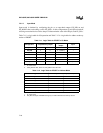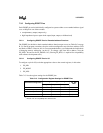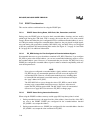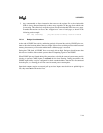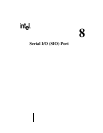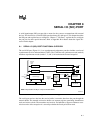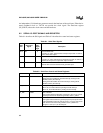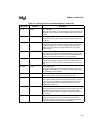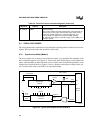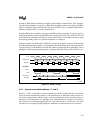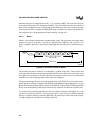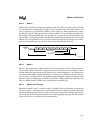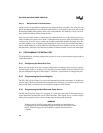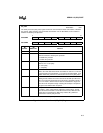
8-2
8XC196NP, 80C196NU USER’S MANUAL
An independent, 15-bit baud-rate generator controls the baud rate of the serial port. Either the in-
ternal peripheral clock or T1CLK can provide the clock signal. The baud-rate register
(SP_BAUD) selects the clock source and the baud rate.
8.2 SERIAL I/O PORT SIGNALS AND REGISTERS
Table 8-1 describes the SIO signals and Table 8-2 describes the control and status registers.
Table 8-1. Serial Port Signals
Port
Pin
Serial Port
Signal
Serial
Port
Signal
Type
Description
P2.0 TXD O Transmit Serial Data
In modes 1, 2, and 3, TXD transmits serial port output data. In mode 0,
it is the serial clock output.
P2.1 RXD I/O Receive Serial Data
In modes 1, 2, and 3, RXD receives serial port input data. In mode 0, it
functions as an input or an open-drain output for data.
P1.4 T1CLK I Timer 1 Clock
External clock source for the baud-rate generator input.
Table 8-2. Serial Port Control and Status Registers
Mnemonic Address Description
INT_MASK 0013H Interrupt Mask
Setting the TI bit enables the transmit interrupt; clearing the bit
disables (masks) the interrupt.
Setting the RI bit enables the receive interrupt; clearing the bit
disables (masks) the interrupt.
INT_PEND 0012H Interrupt Pending
When set, the TI bit indicates a pending transmit interrupt.
When set, the RI bit indicates a pending receive interrupt.
P1_DIR 1FD2H Port 1 Direction
This register selects the direction of each port 1 pin. To use T1CLK
as the input clock to the baud-rate generator, clear P1_DIR.4.
P1_MODE 1FD0H Port 1 Mode
This register selects either the general-purpose input/output function
or the peripheral function for each pin of port 1. To use T1CLK as the
clock source for the baud-rate generator, set P1_MODE.4 to
configure T1CLK (P1.4) for the SIO port.



